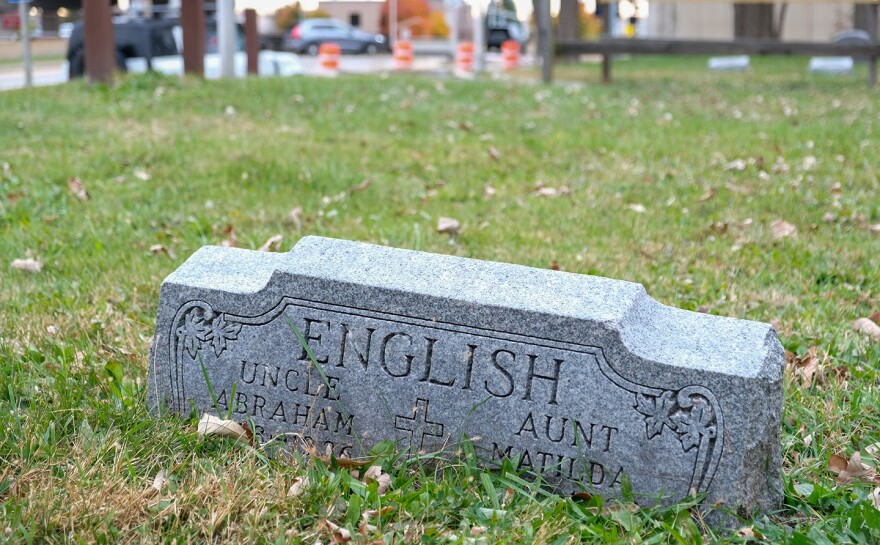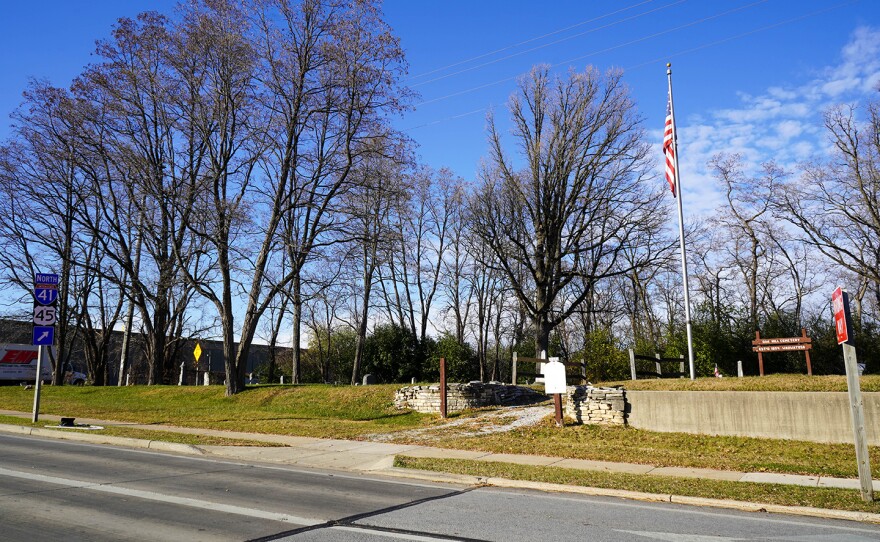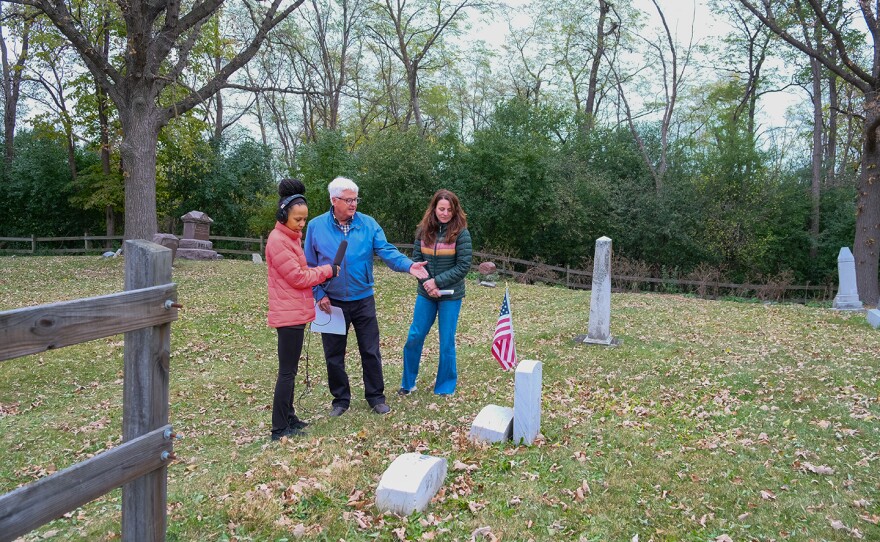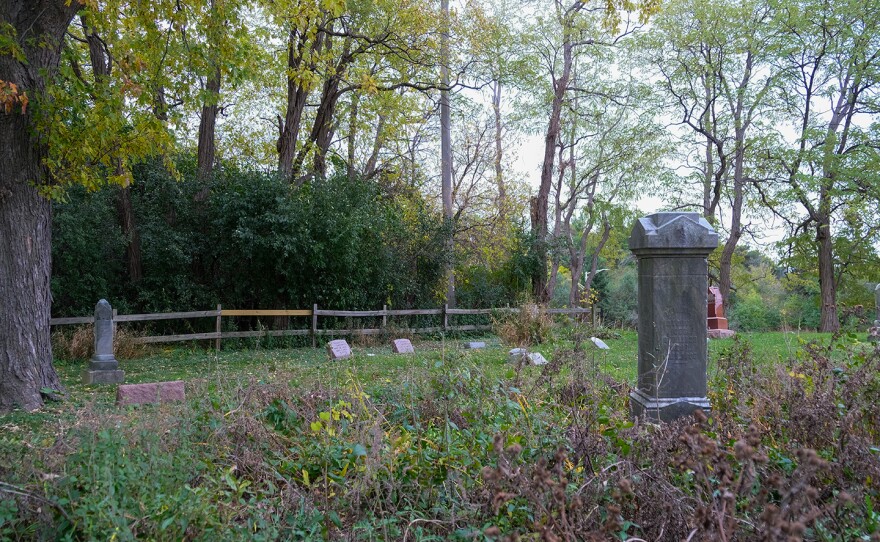They lift your spirits, prompt you to think, make you feel grateful and inspire you to do more. They connect you to our community, shining a spotlight on what's good about our city. They're stories that are Uniquely Milwaukee, sponsored by the Milwaukee Public Library.
Right along West Capitol Drive in Wauwatosa, history hides in plain sight — a time capsule to the city’s past, just off North 119th Street near the northbound I-41/45 ramp. It’s a quiet corner many have driven by and wondered, “What is that?”
The answer: Oak Hill Cemetery, a final resting place on a small plot of land that’s easy to miss and even harder to get to. But that wasn’t the case at the beginning of its story, nearly two centuries in the past. Local historian Jeff Roznowski set the scene.
“If we closed our eyes and pretended it was 200 years ago, this would all be farm land — a saw mill down by the Menomonee River, taverns, farms going on here and just the very gentle quiet but bustling place in the mid-19th century. And here we are today with the final resting place for a lot of our pioneers in Wauwatosa.”
Carving out space
The cemetery was established in 1853, but burials began on the land in 1839. That’s what led former landowner and businessman Clarke Brookins to sell this very small part of his 150-acre property.
“A decision was made … ‘Let’s designate a specific area for a cemetery,” Roznowski explained. “So what Clarke Brookins did was sell one acre of his land for the total sum of $20 and created a burial association for people to put about 140 to 150 plots. … In some ways, he could be considered the father of Oak Hill Cemetery.”
As a local historian, Roznowski and his wife do cemetery tours around the area. He says Oak Hill is different from “mega cemeteries” because of its natural burials that respect the original contour and terrain.
“There isn’t a grid system,” he said. “Everything’s scattered all around. And I think that adds to the quaintness of it, the intimacy of that. … There’s sort of an innocence and a closeness amongst the families that you can only get, I think, with a little cemetery like Oak Hill.”

German and Irish immigrants and farmers are among the people who lay there, some of whom had their headstones inscribed in their native language. Amanda Saso, executive director of the Wauwatosa Historical Society, translated a little as she walked the grounds.
“So on all of the gravestones it says ‘geboren,’ which would be ‘born,’ and ‘gestorben’ would be when they died. And then ‘ruhe in frieden’ means ‘rest in peace,” she said. “It’s kind of cool to see that they were obviously still speaking German when they were here and used them on their gravestones.”
Many of them came from a large group of Germans that settled in Wisconsin in the late 1840s. There could have been many reasons for their transatlantic journey, but one was connected to the Revolutions of 1848 — a series of European revolts against European monarchies. Though it failed, the movement opposed conservative systems in favor of more democratic rule, freedom of the press and working-class rights.
“There was a large immigration over from Germany,” Saso said. “Wisconsin advertised to come to this area because it was so much like Germany, and it really is. If you go to especially southern Germany, it’s very similar, with the farmland and kind of the landscape … and then a lot of beer and brewers and breweries and things like that.”
Standing up to the state
The cemetery’s history also directly ties to the traffic flow of Capitol Drive and its northbound expressway ramp. Back in 1931, when it was still called Plank Road, the state highway department wanted to create a two-lane super highway. Roznowski said this would have meant removing maybe half of the gravesites. The proposal, as you’d expect, upset many people — including one determined woman who fought back.
"There was a wonderful woman known as Aunt Matilda, Matilda English,” Roznowski said. “She was a very spunky woman and when she felt strong about something, she wasn’t hesitant to take drastic measures. So she walked all the way to Madison to lobby the then-highway department to not do this.”
That walk is roughly 80 miles, a trek that Roznowski said others did as well. Together, they convinced state leaders to change their plans. “So what they did was reroute Capitol Drive. Almost in memory of Aunt Matilda, there’s a little jog as you approach I-41 on Capitol Drive where the cemetery is, and that’s due to the spunkiness of Aunt Matilda.”

Like Aunt Matilda, there are many stories of courage and ingenuity within Oak Hill Cemetery. Several veterans also rest here, including one connected to a historic landmark in the heart of downtown Wauwatosa.
“Here we have Levi,” Roznowski said while standing next to one particular marker. “And we have an American flag and a star, which denotes a Civil War veteran. Some Civil War memorial organizations did this back in the late 1860s to commemorate this time within the Civil War.”
Dr. Levi Halsted served as both a private and physician during the war. Before that, in 1854, he built the city’s “Little Red Store.” It’s held various titles over the past 171 years — Halsted’s home and medical practice, a grocery store, a post office, a library and several businesses. These days, it’s managed by the Wauwatosa Historical Society and serves as a nice backdrop for the Saturday farmers markets.
“It’s the longest-standing commercial building in all of Wauwatosa,” Roznowski said. “So for [a person] to bridge the Village of Wauwatosa to the near west side, where we are now, no better than Levi Halsted.”
Tending to the grounds
Since the 1800s, the Oak Hill Burying Ground board has managed the cemetery. Its last living member, Charles S. Stark, took over by default in 1936. His parents are buried here. Unfortunately, after World War II, the cemetery “gradually faded into a virtually unknown and neglected wilderness,” as one article put it. “The last burial happened here in 1951 — somewhat remarkable given that a fire destroyed most cemetery records nearly 40 years earlier.
There was renewed interest in the 1960s, and groups like the Boy & Girl Scouts, veterans and private citizens have occasionally tended to the cemetery. The city of Wauwatosa also says it helps with mowing the grass, tree maintenance and supplying a U.S. flag for a local troop to post.
Roznowski and Saso are both working on ways to keep the history of Oak Hill Cemetery alive, including creating tours that would start in 2026. If yours is one of the many vehicles that pass this place on a daily basis, you’re free to turn into the short gravel driveway and take a respectful look around.















